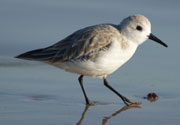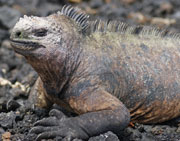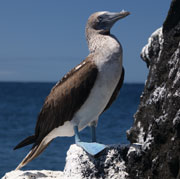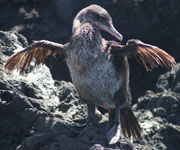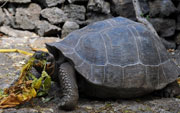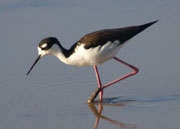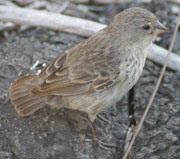| Wildlife |
Punta Vicente Roca, located in the north eastern tip of Isabela, comprises the remains of an ancient volcano which has formed an enclosed bay, free from rough ocean swells. This hidden gem is an idyllic anchorage and is a fantastic place to explore, both above water and by snorkelling. An array of birdlife can be spotted here, including nazca and blue-footed boobies, flightless cormorants and brown noddy terns.
The sheltered waters of Tagus Cove provide ideal conditions for a dinghy ride, which will inevitably provide encounters with flightless cormorants, penguins and pelicans.
Isabela presents fantastic opportunities for bird spotting, with the possibility of seeing American flamingos, lava herons, Galapagos doves, dark-billed cuckoos, Galapagos mockingbirds, ground finches and mangrove finches. Thousands of red-necked phalaropes can be seen on the island, as well as smaller numbers of red phalaropes.
The steady increase of human activity on Isabela is almost certainly accountable for the introduction of a new frog (Scinax quinquefasciata), that has recently been found living on the island. Usually found in the coastal lowlands of Ecuador, the presence of this frog on Isabela is somewhat unwelcome. Little is known about the frog's biology, thus population control methods have proved to be problematic.
Over the past few years, Isabela has played host to some surprisingly late discoveries of new species of wildlife. This has included a new species of land iguana called the Pink Iguana (Conolophus subcristatus rosada), so called because of its colouration. It was first seen by rangers in 1986 by park rangers living around Wolf Volcano - an area which is difficult to visit on land and a place where Aqua-Firma can only explore along the coast. Scientists began to research the pink iguana in more detail in 2000 and calculated that it split genetically from other volcanoes about 5.7 million years ago. It is estimated that there are just 100 alive which means that it is classified under CITES as Critically Endangered.
The yellow iguana was assumed to have been wiped out in Isabela by dogs and other foreign invaders many years ago, but this was re-discovered at Punta Garcia.
Other largely unexplored and forgotten areas of Isabela have recently yielded a wealth of new wildlife discoveries. The lakes contained within the caldera of Cerro Azul, one of the world's most active volcanoes, have been shown to harbour a remarkable array of aquatic life. New species have included groups of nematodes, beetles and dragonflies. Meanwhile, new species of insect continue to be discovered, particularly on the slopes of the northern volcanoes. In 2008 it was discovered that a moth assumed to be just one species, was in fact two: one which inhabits the low arid zones and the other that resides in the elevated areas of Isabela.
Urbina Bay is a seasonal nesting site for much of Isabela's wildlife. In the wet season, giant tortoises journey to the bay to lay their eggs in the sand, before migrating back to the highlands when the lowlands turn dry. A short nature trail here leads to a reef of dried coral heads, molluscs and other organisms, which serve as evidence of a geological uplift from the sea that occurred in 1954. Marine iguanas and flightless cormorants can often be spotted here. Further along the coast at Elizabeth Bay, the extremely endangered mangrove finch can sometimes be seen, which makes this is a popular stop for birdwatchers.
The largest population of giant tortoise in the Galapagos inhabits the grassy slopes around the rim of the Alcedo volcano. Here the tortoises amble steadily along, whilst grazing in the short turfs, then in between meals sit almost motionless, leisurely watching the world go by. The necks of these tortoises are proportionally longer than those of other giant tortoise species, meaning that they are vulnerable to predators as they cannot withdraw enough of their flesh into their shells. Fortunately, Isabela is free from such predators as cats and dogs, so the lack of security that their shells provide is inconsequential. Nevertheless, these shells can at times be problematic for the tortoises. It is almost impossible for the tortoises to rid themselves from pesky skin parasites and ticks, thus they require the assistance from other resident wildlife, of which mockingbirds are always keen to oblige. By way of summoning the mockingbirds, the tortoise raises itself onto its feet and extends its neck. This change in posture is a signal for the mockingbirds to begin their parasite removal service, which they carry out by hopping around the tortoise's skin folds and shell cavity.
Punta Moreno, situated on the western shore of Isabela is a unique location, comprising an array of Galapagos's most spectacular wildlife and fascinating geological detail. The beautiful rocky shoreline is often frequented by Galapagos penguins and other shore birds. A path leads through incredible jagged lava rock formations which encapsulate craters and crystal tide pools, many of which are surrounded by mangroves. Such geological formations provide the ideal habitats for such colourful birdlife as pink flamingos, blue herons, brown pelicans and bahama pintail ducks. These artfully formed lagoons often present the occasional green sea turtle, white-tipped shark and puffer fish.
Photographs kindly provided by Ralph Pannell Galapagos wildlife birdlife birdwatching & natural history holidays - Sail Galapagos islands - expedition cruise vacation holiday - Ecuador responsible travel - Amazon - Andes - Quito - Guayaquil - sky aggressor - Dive Snorkel Diving & Snorkelling - kayak westsuit - Latin & South America journey - Specialist Guided Photography holidays workshops - Charles Darwin Research Station - Galapagos Conservation Trust - Rainforest Concern
The Beagle - Mary Anne - Cachalote - Sagitta - Amazonia - Samba - Beluga - Galaxy - Princess Grace - Aida Maria - Eden - Evolution - Eclipse - Grand Odyssey - Journey I - Eric - Flamingo - Letty - Odyssey - Athala - Nemo I - Nemo II - Diamante - Alta - Lammer Law - Rachel - La Pinta - Humboldt Explorer - Parranda - Isabela (Albemarie) - Santa Cruz (Indefatigable) - San Cristobal (Chatham) - Baltra (South Seymour) - North Seymour (Seymour Norte) - Fernandina (Narborough) - Española (Hood) - Genovesa (Tower) - Bartolomé (Bartolemew) - Santiago (San Salvador or James) - Santa María (Floreana or Charles) - Marchena (Blindoe) - Mosquera - Plaza Sur (South Plaza) - Pinta (Abingdon) - Pinzón (Duncan) - Santa Fé (Barrington) - Rabida (Jervis) - Daphne




